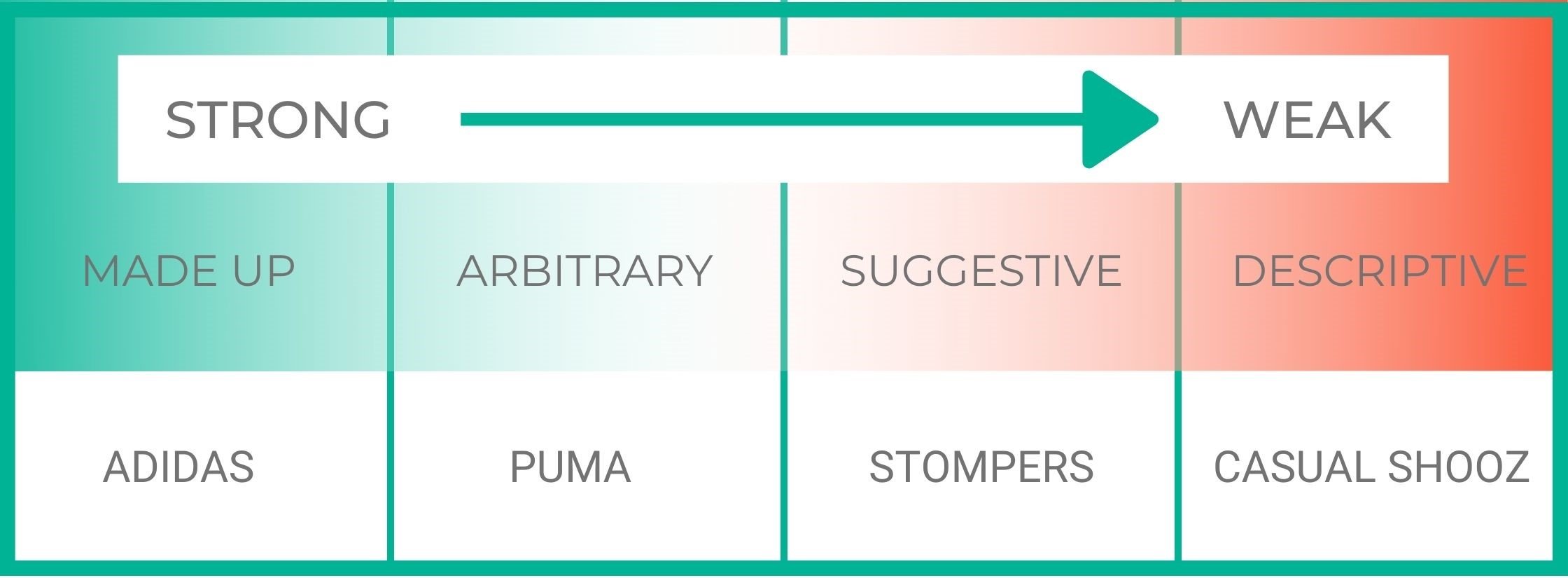How to choose a strong trademark name
Choosing the right brand name can be tricky. You could be naming a future global brand, so choose carefully! Pick a name that consumers can easily recognise and associate with your brand.
The strongest brand names are made-up or invented names, like ADIDAS, while the weakest names are descriptive or generic, like CASUAL SHOOZ.
Table showing a range of examples from strong to weak trademark names
What kinds of names make a strong trademark name?
1. New invented words
Invented or made-up names, sometimes called ‘fanciful’ trademarks, are the most unique and therefore make highly distinctive trademarks. Many top global brands are names consisting of just one unique word, such as:
CASTROL
ZIPPO
ZUMBA
SONY
GOOGLE
Some invented names combine parts of existing words or peoples’ names. A classic UK example is TESCO which was devised from the three initials of TE Stockwell and the CO from the founder, Jack Cohen’s surname. ADIDAS is another good example, derived from the name and surname of founder Adolf (“Adi”) Dassler.
2. Random, arbitrary marks
Words that are completely unrelated to the products and services offered can make a strong trademark name. Think:
SHELL
SKY
VIRGIN
ALIBABA
UBER
PANDORA
And there’s a whole menagerie of animal names used as trademarks that have become well known internationally:
DOVE for cosmetic products
JAGUAR for cars
CROCS, CAT, GRASSHOPPER and PUMA for footwear
THE BEATLES for music bands
Combinations of animal names with another word or an animal sound have proved popular in the tech industry:
FIREFOX
THUNDERBIRD
MAILCHIMP
TWITTER
BUZZFEED
SURFSHARK
3. Suggestive marks
Trademarks that allude to the products or services you offer can make strong brands but are not always the easiest to protect as trademarks - particularly if they verge on descriptive.
Combining two words that would otherwise be descriptive to make an original, new word is a crafty option that many companies have used to create original brand names that allude to the products or services:
VODAFONE - derived from “voice”, “data” and “phone”
WEETABIX - a combination of “wheat” and “biscuits”
VELCRO - a combination of the words "velvet" and "crochet”
AMEX - from the words, “American” and “express”
NETFLIX for movies (flicks) on the internet
BANDAID, ELASTOPLAST, ZIPLOC, INSTAGRAM and SPECSAVERS are other examples using a combination of two existing words that describe some aspect of the company’s product or service.
4 . Generic and/or descriptive marks
Brand names that are descriptive are generally considered the weakest types of names from a trademark protection point of view. While it might be tempting to use words that tell consumers exactly what your products or services are, these industry-related words are usually not registrable as all traders should be allowed to use them.
Examples of businesses which have descriptive names include:
GENERAL COURIER
THE SMARTPHONE COMPANY
CENTRAL AUTO REPAIR ASSISTANT
If you already have a name that is descriptive, you might have more success registering your logo rather than your brand name as a trademark. The companies mentioned above have strategically registered their logos, including their names as trademarks to ensure they have a level of trademark protection:
Examples of logo trademarks registered for generic trademark names
In the long term, it will be worthwhile to take time to come up with a unique name for your business and then protect your name by registering a trademark for your business as soon as possible, before someone else has a chance to imitate your brand.
For the most comprehensive protection, you should trademark your brand and logo as well as every brand asset that you value.
How to get a trademark
With Trademark Planet you can submit your trademark application online in 3 easy steps. Our smart technology streamlines the process so that it takes about 5 minutes to complete:



